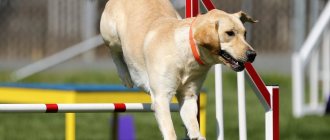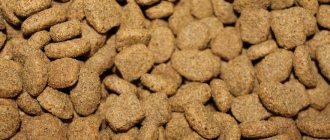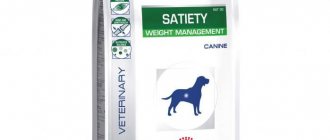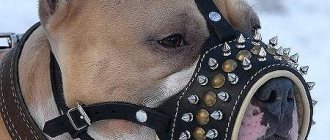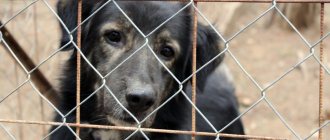Choosing a muzzle is always a big problem for the owner. Which is better? How not to make a mistake with the size? Which muzzle will be more comfortable for a dog? All these questions require an answer and, as a rule, quite urgently. Otherwise, a muzzle that doesn’t fit, at best, will have to be given to friends, and at worst, sent to the trash heap.
In this article, we tried to collect general recommendations for choosing not only the size, but also the type of muzzle suitable for the specific breed of dog and the situation in which it will be used.
Modificationally, muzzles for dogs are divided into deaf and mesh
Deaf
Made from leather or eco-leather, ideal for training. An animal wearing such equipment will not be able to bite the trainer or assistant. But they also have disadvantages: they cannot be worn in hot weather and cannot be worn for a long time - since the animal will not be able to breathe fully, which creates a risk of heat stroke.
How to train an animal to walk in a muzzle
How to choose a muzzle is not all the questions that should concern the owner. It is also important to accustom your pet to walks in equipment.
The first training should be carried out at home, in a calm environment. You need to show your pet the muzzle or even put a treat near it or in it. After a few days, you can move on to the second step - putting the strap on your pet's head. In this case, the treat should be ready. You need to praise your pet for good behavior.
When the animal gets used to the equipment at home, you can go outside with it. If the owner is concerned with the question of how to choose the right muzzle for a dog and buys one that is suitable in size, the animal will not experience difficulties or discomfort when wearing it and will calmly allow it to be put on itself.
How to choose for the breed
The product is selected individually for each dog. The size, character and behavioral characteristics of the individual are taken into account. Approximate recommendations for sizes and types of muzzles:
- Fabric, plastic and leather (lightweight) are suitable for small dogs: dachshunds, bichon frize, maltese, cocker spaniels. The approximate girth of the muzzle is up to 21 cm. This equipment is also suitable for medium-sized pets: fox terriers, miniature schnauzers, whippets (with a muzzle girth of up to 26 cm).
- Plastic and leather (medium weight) are suitable for larger breeds with a muzzle circumference of 30 cm: Aussies, pit bulls, middle schnauzers, standard poodles, border collies and others.
- Metal and heavy leather products are recommended for strong, large or aggressive breeds: Rottweilers, European and German Shepherds, Amstaffs, Cane Corsos, Labradors, Malamutes, Akitos, Kerry Blue Terriers, Golden Retrievers, Great Danes, Mastiffs, Black Terriers, Dobermans and other medium and large Molossians.
Special models - for brachycephalics with a shortened muzzle, suitable for Staffordshire terriers, lapdogs, Pekingese, pugs and others. Every owner, when getting a dog, must provide it with the necessary equipment: a collar, leash and muzzle. It is necessary to take care of the health of your pet, the peace of mind of the pet and the people around you. What do you think about walking dogs without muzzles in public places?
Why does a dog need ammunition?
A muzzle is a thing that makes the owner’s life much easier. Thanks to it, you can avoid many potentially dangerous situations and preserve the health of not only those around you, but also your own pet.
So, according to the law, the animal must be muzzled when walking. This way you will protect not only those around you, but also yourself. It is necessary when traveling on public transport - after all, its passengers may not want to travel even with a peace-loving dog. It is required when visiting a veterinarian - after all, even if the animal is inflicted with minor pain, it can react aggressively. A muzzle is required during training. And it will also prevent the animal from picking up any nasty things on the street.
Choosing ammunition
How to choose a muzzle for a dog? What to look for? These are the questions dog breeders ask. Here are some useful tips.
- Consider your pet's personality. Fighting breeds need a high-quality, strong muzzle. While small, kind dogs will make do with cloth ones.
- Number of fastenings. Choose the ammunition with fewer fastenings. Otherwise, you may get confused while dressing.
- The muzzle must be the correct size and fit snugly. And the animal should feel comfortable in it.
So, how to choose the right size muzzle for a dog is the main question that every dog breeder should consider.
What to do if your dog takes off its muzzle
Like humans, animals sometimes have difficulty getting used to new circumstances or things. Imagine that you want to put glasses on your child, he does not understand what they are and why, and will take them off again and again.
To prevent your dog from taking off his muzzle, it is important to teach him not to be afraid and not to pay attention to this accessory. Use these tips:
- Don't let him play with him, let him know that this is not a toy. After use, keep it out of reach.
- Start working from home. Place a treat inside and offer to take out the treat. Do this many times until your dog starts sticking his muzzle in with pleasure.
- When the dog begins to put its muzzle inside on its own, fasten the straps and feed pieces of treats through the holes in the muzzle. Then we remove the muzzle and stop giving treats. We do this exercise many times so that the dog understands that the treat appears only when the muzzle is on.
- The duration of all exercises starts from a few seconds and gradually reaches several minutes. There is no need to overwork your dog with exercise.
- Associate with pleasant moments. Muzzle = treat.
- Now we go outside. We invite the dog to put his muzzle on the muzzle, then we fasten the belts and go for a walk. We periodically feed the dog treats at those moments when he behaves calmly and does not try to remove the muzzle.
- If you see an attempt to get rid of the muzzle, distract the dog with a toy or action.
- If you are unable to train your dog to wear a muzzle on your own, watch training videos about training using positive reinforcement or use the services of a trainer.
(1 rating, average 5 out of 5)
Halter
A popular configuration is called a halti or loop. This type can be used exclusively for short-term fixation of the dog’s jaws; in addition, for safety reasons and to ensure proper safety, it is advisable that the owner be nearby.
Advantages:
- low price;
- simple design;
- light weight.
The disadvantages include poor fixation and difficulty in putting on the accessory correctly.
Read also: Why are physical exercises needed in class?
How to choose a muzzle for a dog by size: measurement rules, diagram and tips
- 25 May 2022 12:14:27
- Reviews: 0
A necessary condition for keeping a dog and keeping it in public places is the presence of a muzzle. Many owners refuse this type of equipment, explaining this by caring for their pet. But during a walk this is fraught with conflicts. Even a miniature pet can, if not bite, then at least scare a person, especially children aged 2-3 years. Therefore, knowing how to choose the right muzzle for a dog is important not only for your peace of mind, but also for the peace of mind of the public.
How to choose a muzzle for a dog
Additionally, you definitely need to pay attention to two more points: design and material.
By design, all muzzles are divided into 2 types:
- Deaf - maximally closing the mouth, with a dense front part. The dog breathes in them through perforations and usually cannot open his mouth due to the tight fit. In hot weather, there is a risk for a dog to get heatstroke, so such models should be used with caution and only if really necessary.
- Mesh – standard “lightweight” models from a series of straps or rods. Most comfortable for everyday wear.
Important selection rules
So, if you intend to purchase this accessory for your pet, consider a number of mandatory rules and recommendations. They are as follows:
- When choosing a suitable muzzle, take into account the breed characteristics of the puppy and its size. It is easy to guess that a muzzle for a pit bull, boxer, miniature pinscher or shepherd cannot be used for Spitz and Welsh Corgs, or vice versa. Therefore, you must take this feature into account to avoid mistakes when choosing.
- The cost of a specific model is determined by the manufacturer, country and material used in production. If you prioritize saving money, do not forget that the first thing you need to look at is the wearing comfort and durability of the product, and only then the price.
- A muzzle for a pit bull, German shepherd or other large dogs should be comfortable and not put pressure on the nose or area around the eyes when worn. Before purchasing, be sure to try the product on your pet and make sure that he can lick, breathe deeply and open his mouth. This factor is especially important when walking in the hot season, when representatives of large breeds such as mastiffs, lapdogs or pit bulls suffer greatly from the heat and heat.
Interesting fact: if you are wondering how many fastenings a muzzle should have, pay attention to the following features:
- if your dog is calm and balanced, one attachment, which is located behind the ears, is enough;
- If he gets rid of a leather or fabric “mask” without any problems, try to find a more reliable solution.
Muzzle selection table
| DOG BREEDS | MUZZLE CIRCUMSTANCE (CM) | MUZZLES |
| MUZZLES-MET | ||
| SMALL DOG BREEDS | Chihuahua, Miniature Poodle, Phalene, Miniature Spitz, Yorkshire Terrier, English Toy Terrier, Russian Toy Terrier and the like | Muzzle M1 |
| Muzzle M2 | ||
| Muzzle M3 | ||
| puppies, dachshund, fox terrier, Jack Russell terrier and similar | Muzzle M | |
| MEDIUM DOG BREEDS | spaniel, dachshund, poodle, American cocker, English cocker, Weimaraner, etc. | Muzzle SPANIEL |
| Beagle, Cargo, Doberman (female), Russian Greyhound, Afghan, Collie, Spaniel, Schnauzer, Fox Terrier, Pinscher, Weimaraner, Pit Bull Terrier, etc. | Muzzle 26 | |
| MEDIUM BREEDS WITH A SHORT MUZZLE | boxer, bulldog, etc. | Muzzle BOXER |
| MEDIUM AND LARGE BREEDS | German Shepherd, Malinois, Laika, Husky, Labrador, Golden Retriever, Doberman, Dalmatian, Setter, Large Poodle, Airedale, Bull Terrier, etc. | Muzzle 28 |
| Muzzle 30 | ||
| Muzzle 32 | ||
| Muzzle 34 | ||
| Central Asian, South Russian, Caucasian and other large shepherd dogs, Labrador, Malamute, Giant Schnauzer, Newfoundland, etc. | Muzzle 36 | |
| LARGE BREEDS WITH WIDE MUZZLES | bullmastiff, boxer, amstaff, pit bull terrier, staff bull, American bulldog, Dogue de Bordeaux, etc. | Muzzle No. 3 |
| Rottweiler, Labrador, Golden Retriever, large shepherd dogs, Dogue, Dogue de Bordeaux, etc. | Muzzle No. 4 | |
| Muzzle No. 5 | ||
| Great Dane, St. Bernard, Mastiff, Newfoundland, Black Terrier, etc. | Muzzle No. 6 | |
| SOLID MUZZLES | ||
| pit bull terrier, bull terrier, staff bull, etc. | Muzzle PIT CONTINUOUS | |
| boxer, English bulldog, etc. | Muzzle BOXER SOLID No. 0 | |
| German Shepherd, Malinois, Doberman, etc. | SHEPHERD muzzle | |
| boxer, english bulldog, amstaff, staff bull, etc. | Muzzle BOXER CONTINUOUS | |
| Muzzle ROTOR/STAFF CONTINUOUS | ||
| Rottweiler, Bullmastiff, Amstaff, Staffbull, etc. | Muzzle ROTOR SOLID | |
| Central Asian, South Russian, Caucasian and other large shepherd dogs, large malamute, giant schnauzer, Newfoundland, etc. | Muzzle ASIAT solid | |
| UNIVERSAL | Many dog owners consider it unnecessary to put a muzzle on their pet; many feel sorry for the animals. However, we live in a society, therefore, when in public crowded places, a dog needs a muzzle. Even a peaceful Labrador can cause a scandal on the bus. A muzzle is a necessary accessory for a dog. Our article tells you how to choose the right one. |
Taking measurements
The main and important point when choosing clothes and equipment for your beloved pets is taking the correct measurements, which in the future will allow you not to make a mistake with the size. The parameters need to be taken as accurately as possible, close to the dog, but without over-tightening.
Important: for the most accurate indicators, the dog must stand when taking measurements! Its volumes need to be measured in the widest places.
For chest volume, measure the widest part of the chest. For the final result, it is recommended to add a couple of centimeters to the resulting size - for a looser fit of clothing.
To determine the volume of the neck, measure the widest part.
To measure the length of the back, the dog must be standing straight. Using a measuring tape, take measurements from the spine, from the highest point of the back to the beginning of the tail.
Attention: if the animal is large, then one size must be added to the measurement results.
Dog clothing size chart
| Number | Size | Back length | Chest volume | Weight, kg |
| 1 | Xs | 18-21 | 26-30 | 1-2 |
| 2 | S | 22-25 | 31-34 | 2-3 |
| 3 | M | 26-30 | 35-40 | 3-4 |
| 4 | L | 31-35 | 41-45 | 4-6 |
| 5 | Xl | 36-41 | 46-50 | 6-8 |
| 6 | Xxl | 42-47 | 50-55 | 8-10 |
| 7 | Xxxxl | 48-53 | 56-60 | 10-15 |
| 8 | Xxxxl | 54-60 | 61-70 | 15-25 |
| 9 | Xxxxxl | 61-67 | 71-80 | 25-35 |
| 10 | Xxxxxl | 68-73 | 81-90 | 35-45 |
Table of clothing sizes by breed
| Size | Breed |
| Xs | Chihuahua, toy terrier, mini Yorkie, small breed puppies. |
| C | Yorkshire Terrier, Toy Terrier, Maltese, Japanese Chin, Pomeranian Spitz. |
| M | Chinese Crested, Pug, Toy Poodle, Large Yorkie, Shih Tzu, Miniature Pinscher. |
| L | Miniature poodle, shih tzu, fox. |
| Xl | Cocker spaniel, poodle. |
| 2 Xl | Boston Terrier, Shih Tzu, Pug, Cocker Spaniel. |
| 3 Xl | Cocker spaniel, bull terrier. |
| 4 Xl | Golden Retriever. |
| 5 Xl | Golden Retriever. |
| 6 Xl | Saint Bernard, Rottweiler, Bernese Mountain Dog. |
Which muzzle to choose
Experts recommend purchasing several models of muzzles. Using this item of ammunition allows you to:
- Accustom your pet to wearing a muzzle. Products made of nylon and plastic cope well with this task;
- Walk with your pet in public places or travel in public transport. It is unacceptable for an animal to be in crowded places without a muzzle. Therefore, a nylon or plastic option is suitable for a calm pet. And for more aggressive individuals, a leather or metal muzzle will be indispensable;
- A metal or leather product is also suitable for ensuring the safety of others. Thus, a trip to the veterinarian, involving painful medical procedures, is best done with the dog in a muzzle;
- For a safe walk. Many pets have a bad habit of picking up leftover food or other less edible items from the ground. A metal mesh, leather or plastic muzzle eliminates the possibility of developing this unpleasant habit;
- For regular walks without conflicts with others, the risk of your pet picking up something from the ground, etc. in this case, a leather or metal muzzle will become indispensable. If you don’t have the habit of “vacuuming” the ground in search of food, you can use a nylon analogue.
This is important: if the owner cannot independently determine which version of the muzzle for his pet will be universal, then he should seek help from specialists. You can visit a club, a dog show, or consult with a veterinarian. They will certainly help you choose the right model for each dog.
Let's summarize
So, we have looked at all the main types of modern muzzles and highlighted their strengths and weaknesses. As already noted, most owners can safely recommend leather open models or their nylon counterparts, but if you wish, you can, of course, purchase other options. The main thing is not to forget about their reliability and convenience for the dog itself.
Sources:
https://vmiresobak.com/uhod-za-sobakami/kak-vybrat-namordnik-dlya-sobaki-po-razmeru.html https://centr-sobak.ru/blogs/amuniciya-dressirovka-samostoyatelno/kak-vybrat -namordnik-dlja-sobaki-po-razmeru-pravila-izmerenij-shema-i-sovety/ https://24pet.ru/articles/how-to-choose-a-dog-muzzle/
Dog muzzle size table by breed how to measure
Please take just 3 minutes to measure your dog's muzzle and select a muzzle that your pet will feel comfortable wearing.
To do this, you will need a flexible measuring tape, a pen and a piece of paper where you can write down the measurement results.
Before starting measurements, we advise you to draw a table, the form of which is given below:
| Size | Measurement result |
| No. 1: Muzzle length. | |
| No. 2: Muzzle circumference | |
| No. 3: Length to the back of the head. | |
| No. 4: Neck circumference. | |
| No. 5: Width of the muzzle. | |
| No. 6: Muzzle height. |
No. 1: Muzzle length.
No. 2: Muzzle circumference
No. 3: Length to the back of the head.
No. 4: Neck circumference.
No. 5: Width of the muzzle.
No. 6: Muzzle height.
Now you can proceed directly to taking measurements.
- Muzzle length - the distance from the tip of the nose to the transition from the forehead to the muzzle (approximately at the eye line), in centimeters
- Muzzle circumference - the circumference of the muzzle at its widest point (at the transition from the forehead to the muzzle, at a distance of 1.2.5 cm below the eye line) with the mouth closed, in centimeters
- Length to the back of the head - the distance from the transition from the forehead to the muzzle (eye line) to the back of the dog’s head, in centimeters
- Neck circumference - the circumference of the neck behind the ears, in centimeters
- Muzzle width - the width of the muzzle at the widest part, in centimeters
- Muzzle height - muzzle height is measured with the mouth closed at the highest point of the muzzle, in centimeters
- Test yourself: 2*width of the muzzle + 2*height of the muzzle greater than or equal to the girth of the muzzle
Please note that if your dog is not an adult, he will grow and over time you will need to fit a new muzzle.
Even if your dog is good-natured and easy-going, there are many situations when you cannot do without a muzzle. A muzzle is a must for walking dogs, for transportation by public transport, for visiting a veterinarian. In addition, a muzzle can provide safety to the dog itself by preventing the dog from picking up trash from the ground.
The most important requirement for a muzzle is that the dog must be able to open its mouth slightly to cool the body, since heat exchange in dogs occurs through the tongue and oral cavity. Therefore, the main rule when choosing a muzzle is to pay attention to its shape: the muzzle should have the shape of a cylinder.
If reliable fastening of the muzzle is required, a design with an additional forehead strap is needed. The length and degree of tightening of the forehead strap should be such that the upper front part of the muzzle cannot be pushed down under the nostrils.
The muzzle should not fit tightly around the dog's muzzle: it should not put pressure on the bridge of the nose, rub under the eyes, and should not touch the nose - this is very painful. There should be a finger space between the nose and the muzzle.
To determine the size of the muzzle, you need to measure the circumference of the dog's muzzle 1-1.5 cm from the eyes and add 1.5 - 3 cm for the freedom of fit.
How and what to measure?
The first thing to do is take measurements of your pet's face. To do this, it is better to use a soft tailor's measuring tape, since measuring circumferences with a regular ruler or tape measure will simply be inconvenient. If it is not there, you can use any rope or ribbon, then measure them in the straightened state.
To choose a truly comfortable muzzle, you will need to take as many as 4 measurements:
- The length of the muzzle is the distance from the bottom of the nose (the place where the upper lip begins) to the rise to the forehead near the eyes, where the belt that encircles the muzzle with a ring is usually located.
- The circumference of the muzzle is the length of this very belt. Usually another 2-4 cm is added to the measured value so that the dog can open his mouth slightly in the heat.
- Head length is the distance from the bottom of the nose to the bottom of the back of the head, where the muzzle is tightened.
- Neck circumference - from the area under the chin to the lower part of the back of the head. As with the circumference of the muzzle, you can add an allowance of 2-3 cm so that the belt does not put pressure and does not interfere with the animal’s breathing.
For convenience, you can also use the following illustration:
Taking measurements
How to choose the right muzzle for a dog? The first step is to take measurements of the animal in order to purchase ammunition that is suitable in size. So, you need to measure:
- muzzle length (from tip of nose to forehead)
- coverage (the largest place is selected and the circumference is measured, the mouth must be closed)
- distance from the back of the head to the eye line
- neck circumference
- width of the widest part of the muzzle
- muzzle height (with mouth closed)
Correctly taken measurements should correspond to this formula:
- Two muzzle widths + two heights = or > muzzle girth
- For small dogs
How to choose a muzzle for a small breed dog? Yes, the “kids” also need ammunition. But for them it is better to choose models made of nylon or plastic. It will prevent the dog from eating anything from the ground. Also, for breeds such as Chihuahua or Toy Terrier, purchase cat muzzles. But it should be borne in mind that in such ammunition it will be difficult, if not impossible, for the pet to drink or even lick its lips.
Muzzle law
Today there are a number of laws and acts (Federal Law “On the Responsible Treatment of Animals” dated December 27, 2022, Resolution No. 974 dated July 29, 2019), which together give the following picture:
- There are 12 dog breeds that are a priori considered cruel and capable of aggressive behavior. Such fanged ones must always be limited.
- In certain places and during certain events (exhibition, store, transport) absolutely everyone is required to be “in check”.
- Also, do not forget about the distribution of breeds into large and small. The border between these two concepts is weight. So, if your pet is heavier than five kilograms, do not forget to buy a muzzle.
- And remember that only the owner bears full responsibility for the dog’s behavior: if he shits - remove it, causes an accident - finance repairs, rushes, bites - pay for treatment and a fine.
Types of muzzles for dogs
On the shelves of stores and veterinary pharmacies there is a huge selection of muzzles of domestic or imported production. All models can be divided into several categories. Let's look at each of them to get the most complete understanding of the advantages and disadvantages of each type.
Leather muzzle
Leather muzzles are more popular for all types of dogs. The model is a mesh of individual strips of leather or leatherette. They have a number of undeniable advantages:
- Light weight;
- Neat appearance;
- Reliability;
- Does not interfere with a good level of ventilation.
Despite the large number of positive qualities, experts recommend taking into account the disadvantages of such products:
Unscrupulous manufacturers use leatherette, as well as low-quality dyes and impregnations. Your pet increases the risk of developing an allergic reaction when constantly wearing such products;
- Poorly holds its shape, creases may form;
- Fragility. Leather straps often dry out if not stored properly.
Such models have a relatively high price. They can be decorated with rivets or other decorative elements. Widely used for traveling in public transport and on walks.
Plastic muzzle
This product is a lightweight analogue of the metal model. The rods are made not of metal, but of plastic. Dog handlers advise taking into account that this product has a number of advantages:
- It eliminates the possibility of picking something up from the ground;
- Allows you to give your pet something to drink;
- Maintains the required level of ventilation;
- It is light in weight;
- Eliminates the risk of frostbite of the lips and nose in frosty weather.
There is an opinion that this model is ideal for large breeds of dogs. But experts remind that the plastic muzzle has a number of disadvantages:
- Low level of reliability;
- If exposed to low temperatures for a long time, the plastic may crack.
Dog handlers advise using a plastic muzzle in the warm season and only for dogs with a calm and balanced character.
Nylon muzzle
One of the most practical options for the safety of the animal and others. It is a wide strip of fabric that is attached with a fastener. Many manufacturers use a plastic latch because these muzzles are designed for animals with a minimal level of aggression.
The positive qualities of these models include:
- Ease. The product is practically weightless and can be used for pets of miniature or decorative breeds of dogs;
- Practicality. The muzzle washes well and dries quickly;
- Comfort for the dog. The model is made of lightweight but durable nylon; Affordable price.
The nylon muzzle also has some disadvantages that should be taken into account when purchasing the product:
- A low level of ventilation leads to impaired breathing in hot weather and overheating of the pet;
- Low reliability indicators. Dog handlers do not recommend such models for large and aggressive animals;
- Not used for long-term wear;
- Does not exclude the possibility for the dog to pick up food from the ground.
This is important: if the dog is aggressive or inadequate, then you should refuse to purchase such a model. The risk of an animal tearing such a product is too great.
Metal mesh muzzle
A very popular model among owners of medium and large animals. It consists of metal rods intertwined like a basket. Found its application in the southern regions and the middle zone.
Its advantages include:
- Good ventilation, which is of paramount importance in hot climates;
- Reliable fixation of the dog’s muzzle, which ensures maximum safety for others;
- Inability to pick something up from the ground;
- Possibility to drink water;
- Long service life.
We should not forget about the disadvantages of this model:
- In the winter season, there is a high risk of injuring your pet’s lips and nose on the cold mesh;
- Impressive weight compared to other models. It is achieved through the use of metal rods;
- Metal models are used for medium and large dogs. Sometimes there are products on the shelves for representatives of smaller breeds, but they are not widely used.
Loop muzzle (halter)
This model can only be used for short-term fixation of an animal. Experts note that a prerequisite is the presence of the owner in close proximity to the pet.
An unreliable product that the dog can remove at any time. The advantages include light weight, affordable price and compact size.
You may also be interested in our articles: Dog leash. What are they and which one should you choose? and Choosing a collar for the dog. Tips for owners
Material
And the last point is the material. A whole series of qualities depend on it - from weight to reliability.
- Leather is perhaps the most “classic” model. Beautiful, comfortable, reliable, durable. If the size is selected correctly, it does not press, is well ventilated, and does not cause allergies. There are few disadvantages: with frequent contact with water or saliva, it may lose its appearance; It's expensive, but the price is justified by the overall quality and longevity.
- Leatherette - while visually similar to leather in everything except price, it is inferior to it. It wears out faster, cracks, becomes covered with creases, and can cause allergies. Leatherette muzzles should be purchased only for rare use, for example, for occasional trips to the veterinarian.
- Metal – perfectly ventilated, hypoallergenic, does not require special care, extremely reliable, and lasts a long time. Cons: heavy, not used for producing models for small breeds, not suitable for winter walks.
- Plastic is inexpensive, quite safe, muzzles are available in different colors and for almost any breed, can be used in cold weather, and are well ventilated. Cons: not suitable for large, aggressive dogs; may crack and lose its properties in frost or when stored in the sun.
- Nylon – minimal weight (perfect for decorative and toy dogs), easy to wash, durable. Cons: it usually fits tightly around the mouth, preventing the dog from sticking out its tongue (the same problem as deaf models), is not suitable for hot weather, is not very reliable for strong and aggressive animals, due to the open front, it does not prevent the dog from picking up garbage from land.
To summarize, we can highlight a couple of the most universal models - mesh leather or plastic. They are well suited for regular use and are available for most breeds. And for the largest and most wayward animals, it is better to prefer solid leather or metal models, but in this case you need to take into account the season and their level of activity.
Trying is inevitable
No matter how careful the measurements are, the best way to choose is to try them on. Often, having tried on a muzzle you like in a regular pet store, you can rewrite its name and size and order a similar model in an online store, which usually offers a wider range of products and the price of goods is much lower. But whatever the choice and no matter how hard the store consultant tries to help you with it, remember that your dog’s parameters are unique and choosing the right size is not as easy as it seems at first glance.
Taking paw measurements?
To take measurements you will need: paper, pencil and measuring tape. Place the paw on a piece of paper and make a mark from the beginning of the claws to the heel. We look for the resulting distance in centimeters using the table.
Dog shoe size chart in centimeters
| Size | Outsole length | Outsole width | Boot height |
| 2 | 4.80 | 3.50 | 6.50 |
| 3 | 5.50 | 4.00 | 8.50 |
| 4 | 6.00 | 4.50 | 11.00 |
| 5 | 6.50 | 5.00 | 15.00 |
| 6 | 7.00 | 5.50 | 17.00 |
| 7 | 7.50 | 6.00 | 18.50 |
| 8 | 9.00 | 6.50 | 22.00 |
| 9 | 9.50 | 7.50 | 24.50 |
| 10 | 10.00 | 8.00 | 27.00 |
Important! The front paws of dogs are larger than the hind paws; we select the shoe size based on the data obtained from the front paws.
Determine the correct muzzle size
Buying a muzzle is as important as choosing a doghouse or enclosure for your dog. The main condition when selecting this type of ammunition is the pet’s comfort. The protective “mask” should not prevent the dog from breathing, opening its mouth or sticking out its tongue. These are the main criteria in the question of how a muzzle should fit on a dog. To ensure such comfort, it is necessary, even before going to the store, armed with a flexible measuring tape, a pen and a piece of paper, to measure the following parameters:
- The length of the muzzle from the point of its transition to the forehead to the tip of the nose.
- Girth (the tape is placed 1-2.5 cm below the eye line). The measurement is taken with the mouth closed.
- The length of the muzzle from the point of its transition to the forehead to the back of the head.
- The volume of the neck behind the ears.
- The width of the muzzle at its widest part.
Measurements for choosing a muzzle
In order for your pet to feel comfortable in such a device, you need to correctly measure its muzzle.
For this you will need a measuring tape, a piece of paper, and a pen for notes. You must correctly measure in centimeters according to several parameters:
- Muzzle length. It is measured from the tip of the dog's nose to the line of the eyes (the point in the middle between them).
- Muzzle circumference. This is its circumference at its widest point, that is, in the transition zone from the forehead to the muzzle, approximately one and a half centimeters below the eyes. The mouth should be closed.
- Length to the back of the head. Measured from the transition of the forehead to the muzzle to the back of the dog's head.
- Neck circumference. Its circumference is measured behind the ears.
- Muzzle width. It is measured at the widest part.
- Muzzle height. It is measured with the mouth closed at the highest point of the muzzle.
Please note that you are buying a muzzle for a non-adult dog, which will soon need to be changed. After all, the dog is growing, and the parameters of his head are increasing.
Knowing all the dimensions of your dog's head, you can go to the store and select a muzzle for your dog. You cannot go there with your dog without this device. Wearing a muzzle in public is mandatory for all dogs.


